Mathematics and the InternetJanice Staines
Having access to the Internet also means that teachers and children can get access to information that otherwise may not be available to them in books, newspapers or on CD-ROM. For example, the value of ¹ is usually presented to children as 3.142, but they are usually fascinated by the fact that this value is still being calculated. For those with the courage (and the stamina), accessing the site: ftp://uiarchive.cso.uiuc.edu/pub/etext/gutenberg/etext93/pimil10.txt will provide the value of ¹ to 1.25 MILLION decimal places. Alternatively, for those introducing children to the idea of Prime Numbers might want to visit: http://newdream.net/~sage/old/numbers/primeodd.htm where the first 28,915 Prime Numbers are displayed. This may not be something that you spend a week's worth of daily mathematics lessons on, but many children are fascinated by 'big' numbers and so a passing glance at these pages and indeed the whole of the 'Fun with Numbers' site might be worthwhile. http://newdream.net/~sage/old/numbers/
If Fibonacci is more to your liking, then this page is the one for you. http://www.ee.surrey.ac.uk/Personal/R.Knott/Fibonacci/fibBio.html and http://www.ee.surrey.ac.uk/Personal/R.Knott/Fibonacci/fib.html will tell you all you ever wanted to know (and probably a lot you didn't even know you wanted to know) about Fibonacci numbers. Dave's Maths Tables http://www.sisweb.com/math/tables.htm#top is also a 'not to be missed' mathematics reference site. It contains look-up tables on just about every conceivable mathematical topic from simple number notation through areas and volumes up to integral calculus and the Fourier Series. (Don't worry, you don't have to teach this at Key Stage 2!). The Internet can also be a very useful research tool for children. They can use a search engine to find out about a particular topic or famous mathematician but you may need to provide them with support when deciding what keywords they should use in their search. You might find it useful to point them towards a search engine that has been designed with children in mind, Yahooligans, for example.
The Internet can also be used as a research tool in other ways. For example, a class studying the probability of getting a 'HEAD' when a coin is tossed or the probability of throwing a 'SIX' when a die is tossed will have limited data on which to base their findings. Posting a request for other schools to join in the 'Coin Toss' or 'Die Toss' experiment and to share their data will increase the amount of data available for analysis. Alternatively, visiting this site http://bolt.lakeheadu.ca/~kinesiology/Wmontelp/counter3.htm can take away the drudgery of actually tossing the coins – it runs a simulated coin toss for you. Unfortunately, it doesn't count up the numbers of 'HEADS' and 'TAILS' achieved by each experiment, so you still have some work to do.
The Internet is a great place for sharing ideas and information. This is as true for children as it is for teachers. This class of Mixed Junior children at All Souls School in Westminster not only took great pride in displaying their work on Tessellations to the rest of the school, but they were keen to include it on their school web site so it could be enjoyed by people all over the world. You can see their work and that of the other classes by visiting: http://www.rmplc.co.uk/eduweb/sites/allsouls/mthswk/basic.html On the same site, one of the teachers has put up some of the lesson plans and worksheets he has been using based on Logo, spreadsheet and multiplication tables. Sutton-on-Sea County Primary School have published a number of interactive maths ideas on their site: http://www.sutton.lincs.sch.uk/zone/tables/tables.html You can test your skills with your times tables or try out Penny's Penguin Posers.
Other sites provide access to mathematics tools and microworlds which can be used on-line or downloaded for use at a later date. (Some of these sites do require specific 'plug-ins' to work properly, but these can usually be downloaded from the individual sites.) The BBC's 'MegaMaths' is worthwhile visiting if you are a teacher of Key Stage 2 children. It can be found at: http://www.bbc.co.uk//education/megamaths/ and for teachers of Key Stage 1 children then it is also worth visiting BBC Education's 'Dynamo' pages at: http://www.bbc.co.uk/education/parents/dynamo/ Another site that is a useful starting point for mathematics resources is the LCSI site in Canada. http://www.microworlds.com/library/math/index.html This site contains a number of downloadable 'microworlds' for children to investigate and explore including a calculator which uses Roman numerals, a Geoboard investigation and a Tangram puzzle.
http://www.bbc.co.uk/education/schools/ and BECTa hosts curriculum discussion areas on the Virtual Teacher's Centre at: http://forum.ngfl.gov.uk/cgi-bin/WebX?vtc
The Internet is also useful for getting fast access to useful information. For
example, subject associations, software and hardware publishers and government departments
and agencies usually have their own web sites and other organisations will have often
produced subject specific lists of sites that you can visit. Listed below are some useful
sites to get you started, but probably the best idea is to 'take the plunge', set yourself
an hour aside to try out some of the links and see which you will find useful for
supporting your work when teaching mathematics. |
|
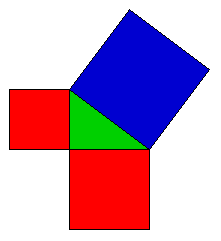 The Internet can be used to support the
teacher in her preparation and presentation of mathematics resources and her pupils with
their learning of mathematical concepts and ideas. The multi-media nature of the Internet
can also enhance the learning experience through the use of colourful graphics, animations
and sounds. The audio/visual aspects of many Internet resources mean that they also can be
used to extend the mathematics curriculum for younger children. For example, an animation
can easily present Pythagoras' Theorem in a form which can be understood by Key Stage 2
children although they might not understand the 'proof' of the theorem until they are much
older.
The Internet can be used to support the
teacher in her preparation and presentation of mathematics resources and her pupils with
their learning of mathematical concepts and ideas. The multi-media nature of the Internet
can also enhance the learning experience through the use of colourful graphics, animations
and sounds. The audio/visual aspects of many Internet resources mean that they also can be
used to extend the mathematics curriculum for younger children. For example, an animation
can easily present Pythagoras' Theorem in a form which can be understood by Key Stage 2
children although they might not understand the 'proof' of the theorem until they are much
older. 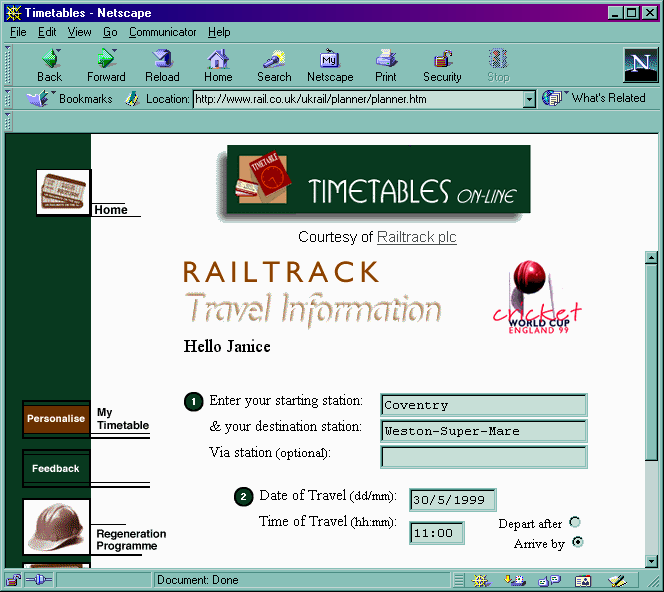 The Internet also provides teachers and children
with access to up-to-date information which will allow 'real time' investigations
to be undertaken. For example, the class may also be monitoring temperature and rainfall
in local, national or international sites. This data may be available in some daily
newspapers, but it is also available on-line. The advantage of having the information
electronically being that it can be easily edited or assimilated into a table, graph or
spreadsheet for analysis. Alternatively, children may be investigating travel times
between different destinations and require access to current timetables and many of these
are now accessible on-line. Children planning a train trip between, say, Coventry and
Weston-super-Mare, can access the Railtrack 'Timetables On-line' site:
The Internet also provides teachers and children
with access to up-to-date information which will allow 'real time' investigations
to be undertaken. For example, the class may also be monitoring temperature and rainfall
in local, national or international sites. This data may be available in some daily
newspapers, but it is also available on-line. The advantage of having the information
electronically being that it can be easily edited or assimilated into a table, graph or
spreadsheet for analysis. Alternatively, children may be investigating travel times
between different destinations and require access to current timetables and many of these
are now accessible on-line. Children planning a train trip between, say, Coventry and
Weston-super-Mare, can access the Railtrack 'Timetables On-line' site:  Perhaps one of the best uses of the Internet for the
teacher of primary mathematics is as a source of reference materials or resources
to be used in the classroom. For the class studying the ancient world, a short biography
of Archimedes might be appropriate. You can find out all about him at this site:
Perhaps one of the best uses of the Internet for the
teacher of primary mathematics is as a source of reference materials or resources
to be used in the classroom. For the class studying the ancient world, a short biography
of Archimedes might be appropriate. You can find out all about him at this site: 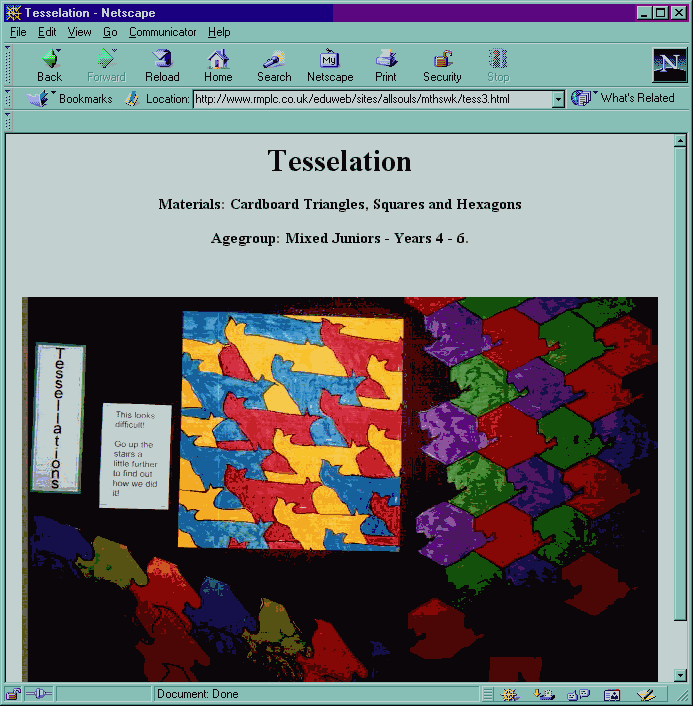 The search engine has already created
categories within which children can search, so under the 'School Bell' category is listed
Math. Children can select this category to narrow down the area within which the search
engine will look for results. Alternatively, if they are searching on details of 'Roman
Numerals' this is listed as a sub-category of 'Math' and can be accessed directly by
clicking on the appropriate link. Other topics might not be found so easily and so the
children will have to type the topic they are searching for in the dialogue box.
The search engine has already created
categories within which children can search, so under the 'School Bell' category is listed
Math. Children can select this category to narrow down the area within which the search
engine will look for results. Alternatively, if they are searching on details of 'Roman
Numerals' this is listed as a sub-category of 'Math' and can be accessed directly by
clicking on the appropriate link. Other topics might not be found so easily and so the
children will have to type the topic they are searching for in the dialogue box.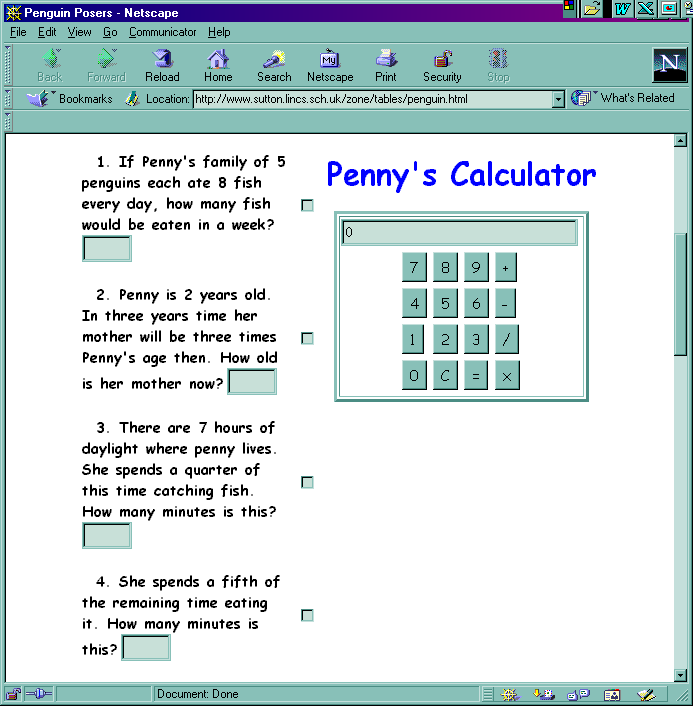 Another useful feature of the Internet for teachers
and children is the possibility of questioning experts. 'Ask Dr Math' is one such
site which allows you to do this.
Another useful feature of the Internet for teachers
and children is the possibility of questioning experts. 'Ask Dr Math' is one such
site which allows you to do this.  Ambleside Church of England Primary School has published
Ambleside Church of England Primary School has published 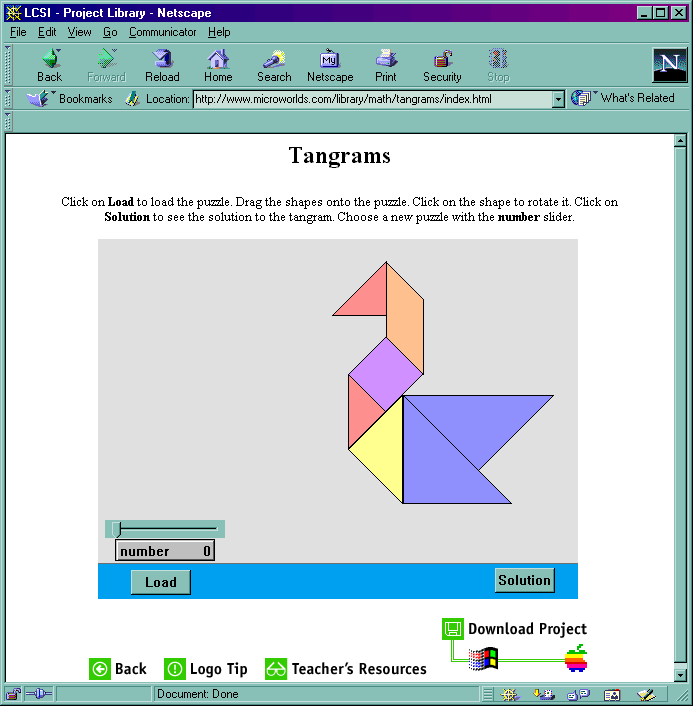 Not all Internet use has to be this structured, other teachers are just keen
to share their ideas. A number of conferences are available where teachers can communicate
and share ideas and concerns. 'Teacher to Teacher' discussion forum can be found
at:
Not all Internet use has to be this structured, other teachers are just keen
to share their ideas. A number of conferences are available where teachers can communicate
and share ideas and concerns. 'Teacher to Teacher' discussion forum can be found
at: